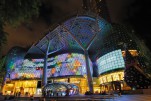Media Façade in the City Environment

Nowadays, media façades have become an accustomed part in the image of various major cities around the world. The concept of the media façade as a fundamental component of the building artistic image gave us the main new rule of architecture perception, i.e. changing the building appearance over time. This time diversity and image variability can work as a utilitarian advertising panel to reflect the functional content of the structure, and on the other side it can influence a person as an effective mean of artistic expression filled with various and multi-layered semantic images.
The skyscraper in its turn being a physically monumental type of structure immediately became a convenient format for demonstrating new artistic and informational capabilities of media technologies. As a result, in recent years several well established types of media façades have appeared that differ in the nature and scale of the building surface coverage, and in technology.
What the modern media façade is and what solutions are most often used in high-rise construction?
In a loose sense, a media façade is a giant screen that covers the entire façade of a building or its individual parts. The screen is a technological system consisting of many LED elements attached to a common frame. The frame can be made in the form of a rigid grid or a system of tubes, or it can have a mesh structure. In all these cases, it is a structure added on top of the main façade of the building and intended for transmitting mainly advertising video content. There are more complex solutions like a variety of LED element integrations into the overall structure of the multi-layer building shell. In this case, lighting control is also included in the general function controlling system of the façade shell and the building as a whole. These solutions provide quite wide opportunities for artistic solutions regarding the architectural image of modern high-rise buildings.
Full content of this issue you can read here
The full version of the article can be read in our printed issue, also you can subscribe to the web-version of the magazine
 Text by Marianna Maevskaya, Researcher at Scientific Research Institute of Theory and History of Architecture and Urban Planning
Text by Marianna Maevskaya, Researcher at Scientific Research Institute of Theory and History of Architecture and Urban Planning


